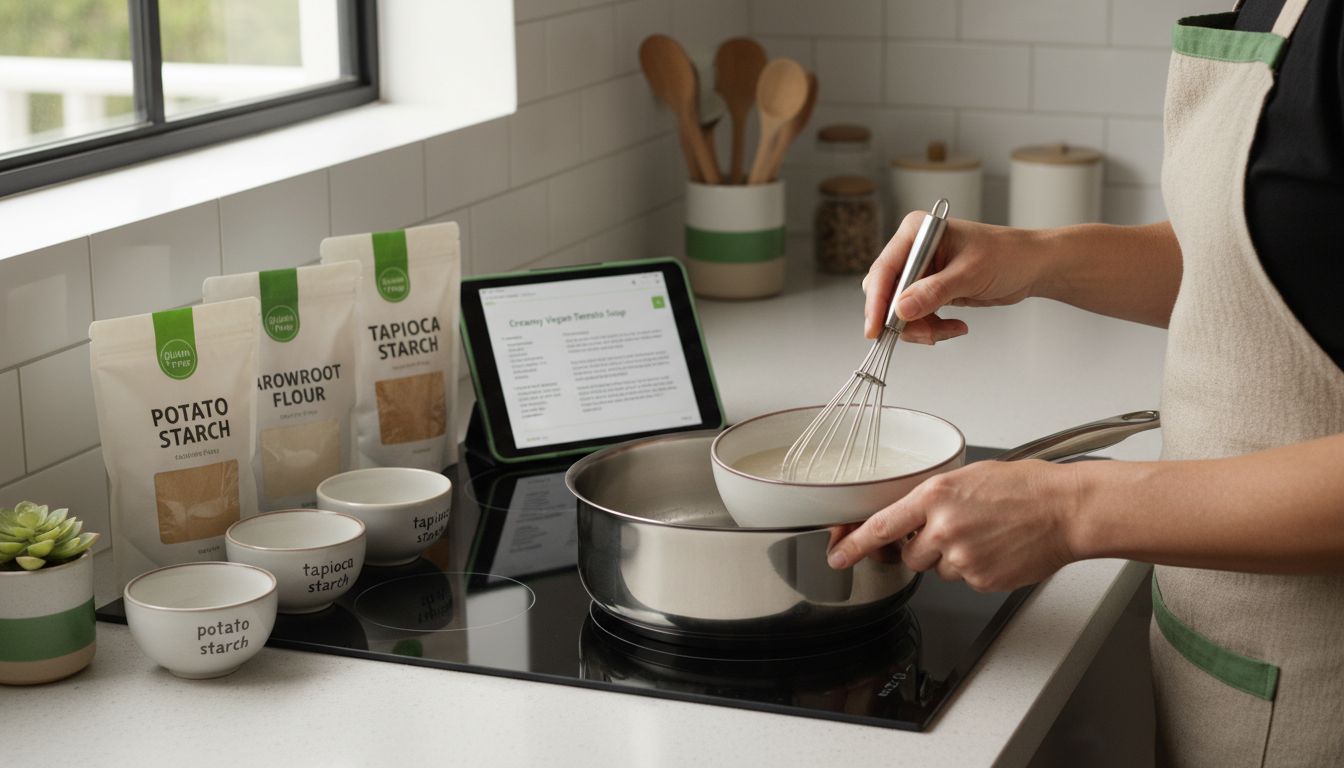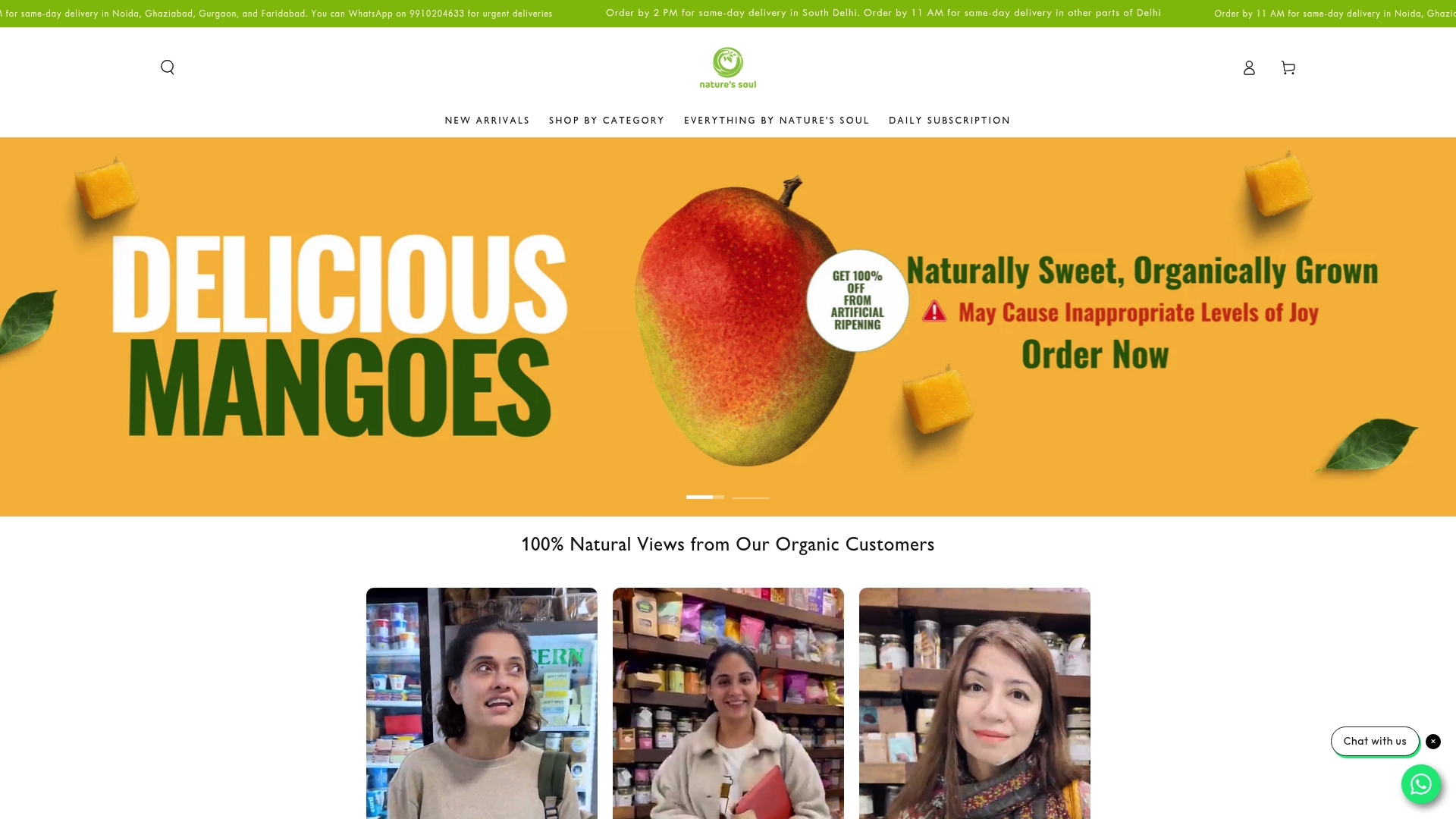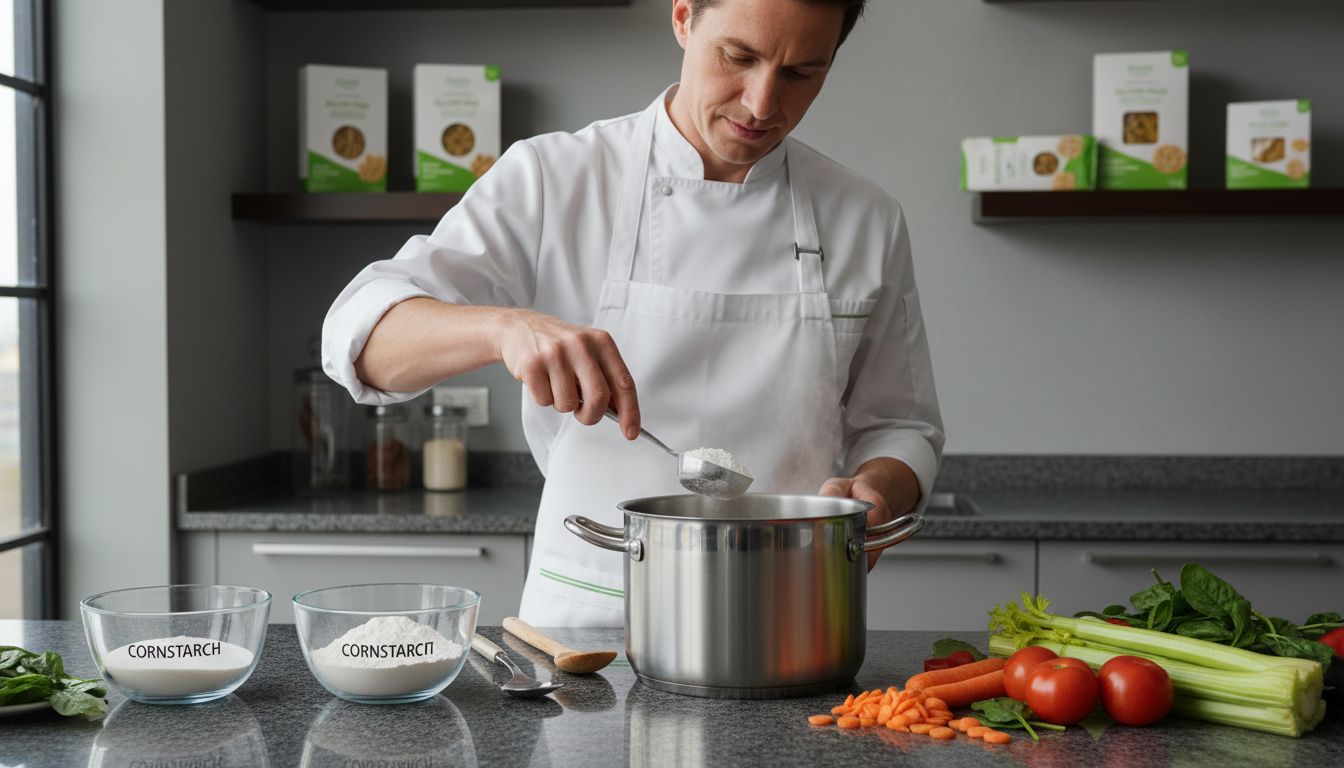Did you know that nearly 1 in 100 people worldwide have celiac disease and must avoid gluten even in soup recipes? Choosing the right thickener can make the difference between a comforting bowl and unpleasant symptoms for those sensitive to gluten. With many soup thickeners now available, everyone can enjoy creamy, satisfying soups without worry or compromise on texture and flavor.
Table of Contents
- What Are Gluten‑Free Soup Thickeners
- Starch‑Based Thickeners Explained
- Gums And Fiber‑Rich Options
- Flour Blends And Roux Techniques
- Purees, Dairy Alternatives, Reductions
- Choosing Safely And Avoiding Mistakes
Key Takeaways
| Point | Details |
|---|---|
| Gluten-Free Alternatives | Gluten-free thickeners like cornstarch, potato starch, and pureed vegetables provide safe options for soups, ensuring texture without gluten. |
| Culinary Potential | Understanding the unique properties of various thickeners enhances culinary creativity while meeting dietary restrictions. |
| Nutritional Benefits | Fiber-rich options such as chia seeds and psyllium husk not only thicken but also add nutritional value, supporting digestive health. |
| Selection Caution | Careful label reading is crucial to ensure product safety, avoiding cross-contamination and incorrect usage that could compromise dish quality. |
What Are Gluten‑Free Soup Thickeners
Gluten-free soup thickeners are natural or manufactured ingredients used to increase the viscosity and texture of soups without introducing gluten proteins. These alternatives help individuals with celiac disease, gluten sensitivity, or those following a gluten-free diet create rich, satisfying soups that maintain a smooth, hearty consistency.
Traditional wheat flour, which contains gluten, has long been the standard thickening agent in many soup recipes. However, gluten-free thickeners offer safe and delicious alternatives that perform similar functions. These alternatives can be derived from various sources including starches, vegetables, seeds, and legumes. Common gluten-free soup thickeners include:
- Cornstarch
- Potato starch
- Arrowroot powder
- Tapioca starch
- Ground chia seeds
- Pureed vegetables
- Rice flour
Choosing the right gluten-free thickener depends on the specific soup recipe, desired texture, and nutritional goals. For instance, cornstarch provides a clear, glossy finish, while pureed root vegetables can add both thickness and nutritional depth. Understanding these alternatives ensures that dietary restrictions do not compromise culinary creativity or flavour.
Here’s a comparison of common gluten-free soup thickeners and their key properties:
| Thickener Type | Common Ingredients | Best Uses | Distinctive Features |
|---|---|---|---|
| Starch-Based | Cornstarch Potato starch Arrowroot Tapioca starch Rice flour |
Clear soups Gravies Sauces |
Glossy finish Neutral flavour |
| Gum & Fibre-Based | Xanthan gum Guar gum Chia seeds Psyllium husk Flaxseed meal |
Creamy or rich soups Healthy blends |
High fibre Stable suspension |
| Flour Blends/Roux | Rice flour & cornstarch Chickpea & potato starch Sorghum & arrowroot |
Stews Sauces Hearty soups |
Custom blends Roux adaptation |
| Purees/Reductions | Vegetable purees Bean purees Nut/seed purees Reduction technique |
Cream soups Vegan dishes Stocks |
Adds nutrients Natural thickening |
For a deeper understanding of gluten and its impact on diet, check out our comprehensive guide on what is gluten.
Starch‑Based Thickeners Explained
Starch-based thickeners are powdery substances derived from various plant sources that create a smooth, viscous texture when heated with liquid. These natural ingredients are essential for gluten-free cooking, offering a reliable method to thicken soups, sauces, and other culinary preparations without using wheat-based products.
Different starch-based thickeners have unique characteristics that make them suitable for specific cooking applications. Some popular options include:
- Cornstarch: Produces a glossy, translucent finish
- Potato starch: Creates a light, crisp texture
- Arrowroot: Works well with acidic ingredients
- Tapioca starch: Provides a chewy, elastic consistency
- Rice flour: Offers a neutral flavour profile
The science behind starch-based thickeners involves gelatinization, a process where starch granules absorb water and expand when heated. This mechanism transforms liquid mixtures from thin and watery to rich and creamy. Temperature and liquid ratio play crucial roles in achieving the desired thickness, with each starch type requiring slightly different preparation techniques.
Choosing the right starch depends on your specific recipe, dietary needs, and desired outcome. Some thickeners work better in cold preparations, while others excel in heated dishes. By understanding the unique properties of each starch, home cooks can elevate their gluten-free cooking with confidence and creativity.

To learn more about gluten and its impact on diet, explore our guide on gluten and gut health.
Gums And Fiber‑Rich Options
Gums and fiber-rich ingredients serve as powerful gluten-free thickening agents that not only enhance soup texture but also provide significant nutritional benefits. These natural thickeners are derived from plant-based sources and offer unique properties that make them excellent alternatives for individuals seeking healthy, dietary-friendly soup preparations.
Some of the most effective gum and fiber-based thickeners include:
- Xanthan gum: Provides exceptional thickening with minimal quantity
- Guar gum: Excellent for cold and hot preparations
- Chia seeds: Adds thickness and nutritional density
- Psyllium husk: Creates smooth, consistent texture
- Flaxseed meal: Offers binding properties and omega-3 benefits
These ingredients work through unique mechanisms of water absorption and gel formation. Xanthan gum, for instance, can create stable suspensions and prevent ingredient separation, making it particularly useful in complex soup recipes. The molecular structure of these thickeners allows them to trap water molecules, creating a smooth, consistent texture without compromising flavour or nutritional integrity.
Beyond thickening, these fiber-rich options contribute additional health benefits. They can support digestive health, provide essential nutrients, and help manage blood sugar levels. Choosing the right gum or fiber-based thickener depends on your specific dietary needs, recipe requirements, and personal health goals.
For more insights into incorporating fiber-rich foods into your diet, explore our comprehensive guide on fiber-rich vegan foods.
Flour Blends And Roux Techniques
Flour blends represent a sophisticated approach to gluten-free soup thickening, combining multiple alternative flour types to create complex, nutritious thickening solutions. According to research, okara flours from chickpea and soy can be particularly effective in increasing viscosity and moisture content in gluten-free preparations.
Gluten-free flour blend techniques typically involve combining complementary flour types to achieve optimal thickening and flavor. Popular combinations include:
- Rice flour and cornstarch
- Chickpea flour with potato starch
- Sorghum flour blended with arrowroot
- Almond flour mixed with tapioca starch
- Quinoa flour combined with rice flour
The roux technique adapts traditional cooking methods for gluten-free requirements. As recommended by culinary researchers, when using alternative flours for gravies and sauces, careful attention must be paid to liquid proportions and cooking instructions. Unlike wheat-based roux, gluten-free versions require precise temperature management to prevent breakdown and maintain desired thickness.
Additional considerations for successful flour blend thickening include understanding each flour’s unique properties, managing moisture content, and balancing flavors. Some flours absorb liquid differently, so experimenting with proportions becomes key to achieving the perfect soup consistency. By mastering these techniques, home cooks can create rich, smooth soups that rival traditional gluten-containing recipes.
For more insights into creating delicious dietary-friendly meals, explore our guide on digestive health foods.
Purees, Dairy Alternatives, Reductions
Purees offer an innovative approach to gluten-free soup thickening, transforming whole ingredients into smooth, nutrient-dense thickeners. According to culinary research, white beans can be expertly pureed and incorporated into soups, creating a creamy texture without relying on traditional wheat-based thickeners.
Different puree and reduction techniques provide multiple gluten-free thickening options:
- Vegetable purees: Roasted root vegetables
- Bean purees: White beans, chickpeas
- Nut-based purees: Cashew cream
- Seed purees: Sunflower seed cream
- Reduction techniques: Slow-simmered vegetable or meat stocks
Researchers have discovered fascinating alternatives to traditional thickening methods. For instance, substituting rice flour with quinoa seed flour in mushroom soup can enhance both nutritional value and physical properties, demonstrating the versatility of plant-based thickeners. Dairy alternatives like coconut milk, almond cream, and cashew-based sauces can also provide rich, smooth textures without gluten.
Reduction techniques involve slowly simmering liquids to concentrate flavours and naturally thicken soups. This method requires patience but rewards cooks with intensely flavourful, naturally thickened broths that avoid artificial additives. The key is maintaining consistent low heat and allowing sufficient time for liquid evaporation.
For more insights into navigating dietary restrictions, explore our guide on gluten-free vs wheat-free differences.
Choosing Safely And Avoiding Mistakes
Gluten-free thickener selection requires careful attention to detail and understanding potential pitfalls. According to research from dietary experts, reading labels meticulously is crucial to ensure product safety and prevent potential gluten contamination during food preparation.
Key considerations when selecting gluten-free thickeners include:
- Certification: Look for verified gluten-free labels
- Processing: Check for potential cross-contamination risks
- Ingredient transparency: Understand complex ingredient lists
- Sensory profile: Consider how thickeners impact taste and texture
- Nutritional value: Evaluate additional health benefits
Research highlights that xanthan gum, for example, can significantly alter soup viscosity and consumer perception of thickness. This means that beyond safety, home cooks must consider how different thickeners interact with other ingredients and impact overall dish quality. Some thickeners might change flavour profiles or create unexpected textures if not used correctly.
Common mistakes to avoid include assuming all alternative flours are automatically gluten-free, neglecting to verify manufacturing processes, and using incorrect quantities that can compromise soup consistency. Experimenting with small batches, understanding each thickener’s unique properties, and maintaining a cautious approach will help ensure delicious, safe gluten-free soups.
For additional guidance on navigating dietary restrictions safely, explore our guide on cross-contamination in gluten-free cooking.
Discover Safe and Natural Gluten-Free Soup Thickeners for Your Wellness Journey
Navigating the challenge of thickening soups without gluten can feel overwhelming. The article highlights the importance of choosing the right gluten-free thickeners like cornstarch, arrowroot, and chia seeds, while avoiding hidden gluten contamination that risks your health and wellness. If you seek to create hearty, delicious soups free from gluten yet rich in texture and nutrition, you are not alone in your goal.

At Nature’s Soul Shop, we understand your need for clean, organic, and natural ingredients that support your gluten-free lifestyle with confidence. Explore our selection of gluten-free flours, starches, and fibre-rich options that perfectly complement the techniques shared in the guide. Take control of your cooking today by visiting our homepage and discover how easy it is to elevate your meals safely and deliciously. Start your gluten-free wellness journey now and enjoy the peace of mind that comes with trusted, natural products.
Frequently Asked Questions
What are gluten-free soup thickeners?
Gluten-free soup thickeners are natural or manufactured ingredients that increase the viscosity and texture of soups without using gluten proteins, making them suitable for individuals with celiac disease or gluten sensitivity.
What are some common types of gluten-free thickeners?
Common gluten-free thickeners include cornstarch, potato starch, arrowroot powder, tapioca starch, ground chia seeds, pureed vegetables, and rice flour, among others.
How do I choose the right gluten-free soup thickener for my recipe?
Choosing the right thickener depends on the soup recipe, desired texture, and nutritional goals. For instance, cornstarch offers a glossy finish, while pureed vegetables add both thickness and nutrients.
What is the role of starch-based thickeners in gluten-free cooking?
Starch-based thickeners are derived from various plant sources and help create a smooth, viscous texture when heated with liquid, making them essential for thickening soups and sauces in gluten-free cooking.
Recommended
- What is Gluten? Understanding Its Role and Impact – naturessoulshop
- Gluten and Gut Health: Everything You Need to Know – naturessoulshop
- Understanding Is Tofu Gluten Free: Key Insights Explained – naturessoulshop
- Understanding Gluten Free Cooking Utensils: A Clear Guide – naturessoulshop
- How to Make Gluten-Free Porridge: Nutritious and Easy Recipe – Granavitalis
- What is Gluten-Free Thai Cuisine? Understanding Its Flavors






